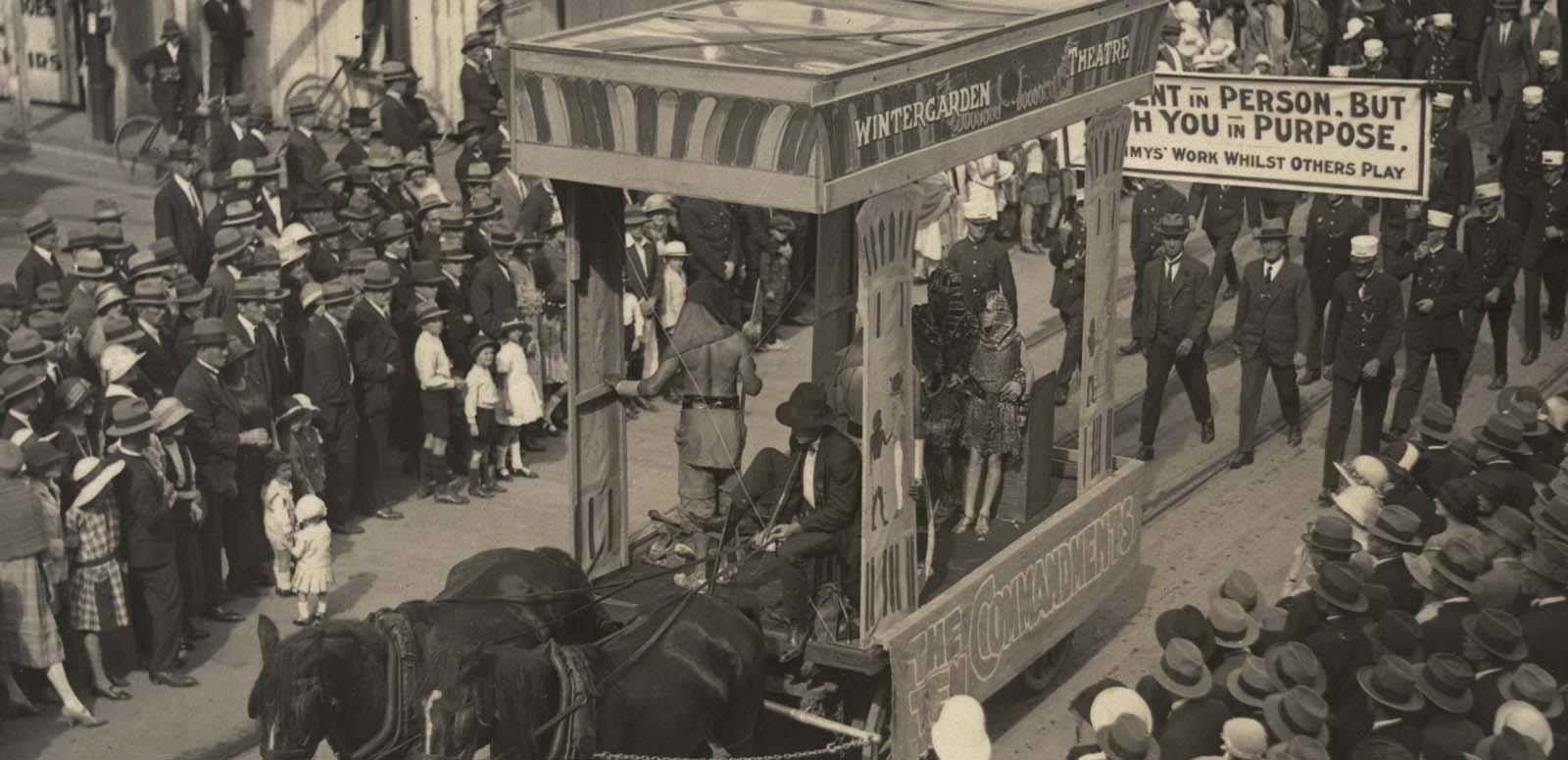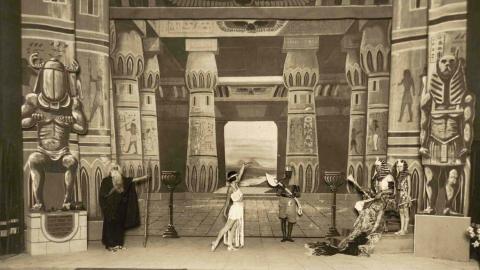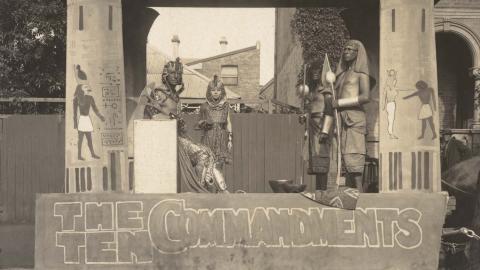

Hollywood in Australia: Part 3
Hollywood, local filmmakers and regional Australia intersect in the story of Franklyn Barrett’s touring of a live prologue to Cecil B DeMille’s The Ten Commandments in Far North Queensland, 1925.
Jeannette Delamoir researched the NFSA Franklyn Barrett Collection as part of her Scholars and Artists in Residence Fellowship at the NFSA in May 2011.
Working for the enemy
Looking at these tours gives insight into Barrett’s personality and this phase of his life. His wide range of practical skills – musical, electrical, mechanical – and his versatility and adaptability are evident, in addition to his ability to get along with people. One anonymous admirer describes all Barrett’s responsibilities while travelling:
I learned that Frank was also running the – Exploitation he called it – well, it was a ‘newy’ on me, but I found that there was more to it than an ordinary man could carry out. It seemed necessary to be a producer, an electrician, a musician, a publicity man, an operator (for I heard him instructing the Operator on speeds and arc-lamps, and giving him a lecturette on Technicolor), a theatre manager, an accountant, and several other things beside … He certainly has some job, but he measures up to it.(88)
Other pioneering filmmakers shared Barratt’s adaptability and, like him, took up this sort of work. At precisely the same time that Barrett was travelling Queensland, Beaumont Smith also toured the Birch, Carroll and Coyle circuit. Accompanied by a cameraman, he conducted ‘screen tests’, ‘in the hope of lighting on some latent talent in the Far North, now languishing for the want of a little encouragement.’(89) Roland Stavely, who made The Enemy Within (1918) with Barrett, also travelled with a ‘screen test’ act, competing with Smith for regional audiences.(90)
These out-of-work filmmakers found new places within the Australian film industry – an industry in which, by 1925, the growth area was exhibition, rather than production. Barrett’s next life stage was the management of movie theatres, beginning with the Canberra Capitol in 1927.(91) Then followed 25 years managing a number of Hoyts theatres in Sydney, which allowed him to care for his wife Mabel who suffered from Parkinson’s disease.(92)
Barrett’s time with Paramount can be interpreted as enforced and humiliating work for ‘the enemy’. Or, from a different and more positive perspective, it could be seen as an invitation to learn from the world’s foremost film company, an experience that aligns with global perspectives that Barrett formed early through his work with Charles Urban and Pathé Frères.
The history of cultural practices

If anyone needs to be convinced about the value of looking at Franklyn Barrett’s Ten Commandments tour, that person only needs to consider it through the perspective of ‘the history of cultural practices’.(93) Rather than simply studying a film as a ‘text’, this approach accepts that texts and meanings are not stable, but depend on the environment in which they are experienced, the business practices involved, and the social and cultural make-up of the audiences.
This emphasises the broader experience of cinema, and also encourages an exploration of how people respond beyond the metropolis —say, in regional and niche markets, the very locations where Barrett presented his show.(94)
Certainly some viewers of The Ten Commandments were aware of how conditions shaped their experience of the film. The Rockhampton police magistrate, giving evidence to the Royal Commission in 1927, said:
The environment in which you view a picture has an effect upon your mind. At St Lawrence, or even at Gladstone, you would not expect to find the same class of picture as you would in Rockhampton; and in Rockhampton you do not get the same class as you do in Brisbane, Sydney, or Melbourne. You probably get the film after it has been well worn in the southern cities. Take The Ten Commandments as an example. I saw that in Sydney at the Prince Edward Theatre. I also saw it here [Rockhampton]. It was the same picture, but the setting in Sydney was such that you could view it three or four times. Then you might see it at St Lawrence, in an open-air theatre, sitting on a hard seat with no back to it. Each viewing of the picture would have a different effect upon your mind.(95)

The details contained in Barrett’s notebooks that tell us about theatres, seating, ownership and theatre equipment are immensely valuable because such details are often elusive. In addition, they help build a better understanding of business practices within the Australian film industry. When we know, for example, the numbers and kinds of seats in various theatres, and price structures for the different sections, we can begin to construct a sense of how many people went to the theatre, and what it cost them to go. This in turn suggests social hierarchies within the seated audience, which further suggests the social make-up of the audience. A theatre in a low-income town would probably have a small proportion of high-priced seats – or none at all.
Against this background, we can begin to grasp why exhibitors accepted such crippling terms in order to show The Ten Commandments. Far from being passive victims of American companies, the exhibitors made conscious commercial decisions. Patrick English, of Malanda Pictures, told the Royal Commission: ‘I show [the big attractions like The Ten Commandments ] only in order to give my patrons a chance of seeing the best pictures that are offering. I lost money on that.’96
In other words, screening the ‘super film’ built audiences. It brought in those people who had not, up to that point, seen a film at all, and in towns with more than one picture theatre, showing The Ten Commandments helped develop customer loyalty and differentiate one theatre from another.
Local audiences

How did audiences receive the prologues? Very few reviews of the film in local papers discuss the prologue; the magnificence of the film itself seems to have swept away any mention of the live ‘actors’.(97)
Furthermore, the Ten Commandments prologue showed the death of the Pharaoh’s son – that is, it presented on the stage a scene that the audience would see on-screen, again, a few minutes later. As full of drama and pathos as it might be, why repeat this scene?
Further research may turn up records of audience responses, but my preliminary guess is that the live performance performed complex and contradictory functions. The local, amateur players built an emotional bridge between the audience – their peers – and the ancient, distant world on screen. The Old Testament drama within the film is then infused with a sense of grief and loss generated by the ‘local’ live performers. Oddly, the ‘bad guy’ – the proud, cruel Pharaoh – becomes a sympathetic human being in a way that the ‘good guy’ – patriarchal, angry Moses – is not, and the film’s moral lesson is taught in emotional terms.
Sumiko Higashi, among other American film historians, has written about how DeMille’s films promote consumerism. Higashi claims that this ‘modern consumer ethos’ had the effect of ‘homogenising’ regional audiences that were, across the United States, diverse in gender, class and ethnicity.(98) Certainly evidence given to the 1927 Australian Royal Commission reveals a fear of an ‘Americanisation’ in terms of Australians using American slang or modelling their behaviour on that seen in films. For example, journalist Charles Griffith from Gladstone refers to ‘an imposition of the American viewpoint and custom on our civilisation. Their customs are entirely different from ours.’(99)
However, local responses to films and ‘Americanisation’ are, at the same time, often resistant and complex, as demonstrated by Barrett’s interactions with theatre proprietor Mr Carler. So how can these complicated, localised responses be teased out, especially given that the tour is too long ago for living memory?
To some extent, any text ‘constructs’ its audience by its assumptions about who it is engaging. Audiences also ‘construct’ meanings from the film text, their interpretations being shaped by their social and cultural concerns. This can be illustrated through one intriguing example of location shaping possible meanings: the use of leprosy as a symbol of moral contagion in The Ten Commandments. Leprosy first appears in the ancient section of the film, seemingly as a direct result of sexually charged fondling of the Golden Calf idol. Then, the modern section specifically connects the disease with a mixed-race ‘Eurasian’ woman played by Nita Naldi.
In the post-colonial state of Queensland, leprosy had particular racial significance. During the very year that The Ten Commandments toured north Queensland, Dr Raphael Cilento, based at the Institute of Tropical Health in Townsville, published The White Man in the Tropics, which emphasized a racialised idea of public health in which ‘the native body’ was seen as ‘the unsanitary other of the white body’.(100) At the end of the nineteenth and beginning of the twentieth centuries, Queensland newspapers used leprosy, plague and typhoid to link race with ideas of dirt and disease.(101) And, since cleanliness was next to Godliness, the ‘dirtiness’ of the racial Other was seen as a spiritual and moral failing as well.
In The Ten Commandments, the ‘hybrid’ Eurasian woman carries the additional interpretive burden of miscegenation, with its notions of racial contamination. And leprosy was, in 1925, a particularly current issue, following a nationwide panic when rats with leprosy were found in Rockhampton and Cairns(102). Amid other incidences of leprosy in humans, ‘an elderly kanaka’ at Mossman was diagnosed with leprosy in March.(103)
For white Queenslanders, then, the use of leprosy as a symbol would be likely to reinforce social and spatial regulation of Indigenous, Asian and immigrant people. Although there is little official record of the practice, Indigenous people were often forced to sit in the ‘hen’s roost’(104) in picture theatres, and many communities had segregated districts such as ‘Chinatown’, ‘Malaytown’, or ‘Kanakatown’.(105)
Research into these ‘hidden’ histories is difficult, since there is little information about audiences in the silent era. Yet there are many important stories that could be drawn from looking at the audiences in context. For instance, the gender (heavily male) and age dimensions (predominantly young) of the Queensland population also surely influenced responses to The Ten Commandments.
Another influencing factor would have been attitudes to religion in 1925 Queensland. Cairns Shire Council did discuss whether Beattie’s Pictures in Babinda should be allowed to screen The Ten Commandments on Christmas evening(106); Gordonvale and Babinda had earlier in the year already drawn attention for allowing amusements to open on Sundays.(107) But Far North Queensland also had visible signs of non-Christian religious practice such as joss houses and Chinese cemeteries. Communities with large Italian populations had visual evidence of non-Anglo worship in the form of Roman Catholic churches and public rituals such as processions.
Conclusion

These differing perspectives on the tour lead into a broader consideration of the ways that regional, national and global cultures intersect. Franklyn Barrett’s tour of The Ten Commandments exposed regional communities to a film on a scale that simply could not have been made by the Australian film industry, and introduced methods of film presentation and promotion that were more closely associated with metropolitan centres.
Moving pictures insinuated themselves into the core of communities, with the US film industry promoting theatres as valuable civic centres. Paramount advertised in The Courier Mail in 1925:
Then the theatre came! And at once business and civic life gained a new interest … the entire community’s meeting-place for life at its most enjoyable … Any town’s a richer place with the better pictures – Paramount, richer in life, trade and happiness.(108)
Earlier that year, the Rockhampton Morning Bulletin pointed to Australia’s distance from world centres as one reason why motion pictures were so valued:
Here, thousands of miles from the seats of learning and art in the New and Old World, we are, through the medium of the motion picture, able to know the events of improvement and see the reflection of life.(109)
In other words, the desire to feel up-to-date and connected with the wider world is possibly even more powerful in regional and remote areas than it is in cities.
Understanding how people outside the metropolitan centres interact with global popular culture creates a type of self-awareness even more valuable amid the heightened media connectivity of 21st century.
The small-town movie theatre – ‘a site where community was constituted … a testament to the resilience of the local within a marketplace of commodified mass entertainment’(110) – is a place rich in shared memories. The history of film is more than a history of production; the experience of filmgoing creates a rich tapestry of tensions, connections, and interactions, with each community weaving its own distinct patterns of pleasures and practices.
Jeannette Delamoir, who taught at Central Queensland University in Rockhampton, Queensland, for 11 years, is currently living in Sydney. She is undertaking her second PhD and writing a creative non-fiction manuscript about the Great Mahatma Company, a performing troupe that toured Queensland in 1913, presenting entertainments including sleight-of-hand, escapology, clairvoyance, sentimental ballads, and motion pictures.
Endnotes for part three
88‘An Appreciation’, not dated, not signed, carbon copy of type-written manuscript. Franklyn Barrett Collection: The Ten Commandments Tour: Assorted Papers, NFSA: 763988.
89Everyones, 17 June 1925, p 10.
90Advertisement for Tivoli Theatre, Morning Bulletin (Rockhampton), 1 July 1925, p 2.
91‘Oldest Movie Man: Manager of the Capitol: Future Policy Announced’, Canberra Times, 15 November 1927, p 1.
92‘Franklyn Barrett Filmed Kings – When Magnates Were Migrants’, 1953, The Showman, July in Franklyn Barrett: ‘Press Book’, c1906-1987, NFSA: 755785-001 / RDP001536.
93Charles Musser, 2004, ‘Historiographic Method and the Study of Early Cinema’, Cinema Journal, Vol. 44, No. 1, p 106.
94Australian research projects investigating regional filmgoing and exhibition include two funded by Discovery Grants awarded by the Australian Research Council (ARC):
Kate Bowles, Richard Maltby, Deb Verhoeven and Mike Walsh: ‘Regional Markets and Local Audiences: A History of Australian Cinema Consumption’;
Colin Arrowsmith, Kate Bowles, Richard Maltby, Jill Julius Matthews, Deb Verhoeven and Mike Walsh: ‘Mapping the Movies: The Changing Nature of Australia’s Cinema Circuits and their Audiences 1956-1984’.
Other research in this area includes:
Julie James Bailey, 1997, ‘Independent Film Exhibition: Country Queensland from the 1930s to the 1960s’, Media International Australia, No. 85, pp 110-115.
Ina Bertrand, 2006, ‘“Bring[ing] Family Life into Theatres”: The Drive-Ins of Western Australia’, Screening the Past, latrobe.edu.au/screeningthepast/19/drive-ins-WA.html, viewed June 8 2011;
Kate Bowles, 2007, ‘“Three Miles of Rough Dirt Road”: Towards an Audience-Centred Approach to Cinema Studies in Australia’, Studies in Australasian Cinema, Vol. 1, No. 3, pp 245-260.
Kevin Cork, 1995, ‘Cinema as “Place”: The Case of the Picture Theatres in a Group of Towns and Villages in the Central West of New South Wales’, People and Physical Environment Research, No. 49, pp 34-49.
Deb Verhoeven, 2007, ‘Twice Born: Dionysos Films and the Establishment of a Greek Film Circuit in Australia’, Studies in Australasian Cinema, Vol. 1, No. 3, pp 275-298.
Dylan Walker, 2007, ‘Rural Cinema Audiences in South Australia in the 1930s’, Studies in Australasian Cinema, Vol. 1, No. 3, pp 353-375.
Mike Walsh, 2007, ‘Cinema in a Small State: Distribution and Exhibition in Adelaide at the Coming of Sound’, Studies in Australasian Cinema, Vol. 1, No. 3, pp 299-313.
Anne H Wilson, 2006, ‘Modernity and the Film Exhibition Industry in Gippsland: The Glover Family Business 1926-1973’, Senses of Cinema, No. 41, http://www.sensesofcinema.com/2006/41/modernity-gippsland-glover/, viewed June 8 2011.
95Australian Government, 1927, Commonwealth of Australia: Royal Commission on the Moving Picture Industry: Minutes of Evidence, Canberra: Government Printer. Witness: Thomas Farnell, p 302. St Lawrence is a small coastal settlement north of Rockhampton.
96Australian Government, 1927, Commonwealth of Australia: Royal Commission on the Moving Picture Industry: Minutes of Evidence, Canberra: Government Printer. Witness: Patrick English, p 296.
97More research in regional newspapers is still to be undertaken in publications that are not yet available online through the National Library of Australia’s Trove Digitised Newspapers. This research may reveal greater discussion of the prologue.
98Sumiko Higashi, 1996, ‘Antimodernism as Historical Representation in a Consumer Culture: Cecil B DeMille’s The Ten Commandments, 1923, 1956, 1993’, in Vivian Sobchack (ed.), The Persistence of History: Cinema, Television, and the Modern Event, New York: Routledge, pp 97-98. See also Lary May, 1983, Screening out the Past: The Birth of Mass Culture and the Motion Picture Industry, Chicago: University of Chicago Press (first pub. 1980).
99Australian Government, 1927, Commonwealth of Australia: Royal Commission on the Moving Picture Industry: Minutes of Evidence, Canberra: Government Printer. Witness: Charles Griffiths, p 242.
100Robert Dixon, 2001, Prosthetic Gods: Travel, Representation, and Colonial Governance, St Lucia: University of Queensland Press, p 24.
101Dixon, p 31.
102‘City Health: Dirty Restaurant Premises: Boarding House Registration’, Morning Bulletin (Rockhampton), 22 January 1925, p 12.
103‘Mossman’, Brisbane Courier, 23 March 1925, p 7.
104Julie James Bailey, 1997, ‘Independent Film Exhibition: Country Queensland from the 1930s to the 1960s’, Media International Australia, No. 85, p 110.
105For instance, Innisfail’s notorious Chinatown was described as ‘that smelful quarter … a veritable social sore’ (‘Disturbance by Malays’, Cairns Post, 14 December 1925, p 4). ‘Mohammadan’ Malayans and Indigenous residents lived right on the sea in Malaytown in Cairns (Mary Guthrie, ‘Sugarlands: A Romance of North Queensland Chapter X’, Queenslander, 18 October 1924, p 43; ‘A Cairns Charge’, Cairns Post, 23 December 1925, p 5). In 1883, WK Higson, successful Queensland Legislative Assembly candidate for Rockhampton, addressed a meeting at the Rockhampton School of Arts. He commented on Kanaka Town in North Rockhampton: ‘A race was growing up alongside their own children and what would the people of this colony become but a mixed race. (A voice: Piebalds.)’ (‘Representation of Rockhampton’, Morning Bulletin, 14 August 1883, p 2).
106‘Sunday Night Pictures’, Cairns Post, 9 November 1925, p 4.
107‘Sunday Picture Shows’, Cairns Post, 17 January 1925, p 4.
108Advertisement for Paramount Pictures, Brisbane Courier, 31 October 1925, p 3.
109Morning Bulletin (Rockhampton), 17 March 1925, p 11.
110Gregory A Waller, 2005, ‘Imagining and Promoting the Small-Town Theater’, Cinema Journal, Vol. 44, No. 3, p 15.
The National Film and Sound Archive of Australia acknowledges Australia’s Aboriginal and Torres Strait Islander peoples as the Traditional Custodians of the land on which we work and live and gives respect to their Elders both past and present.


